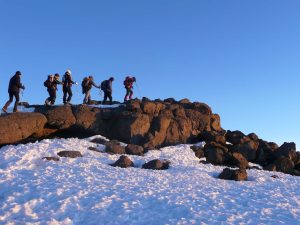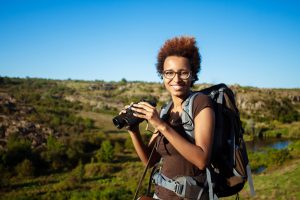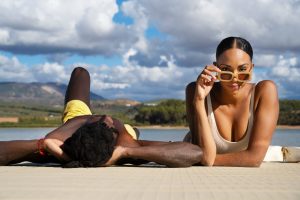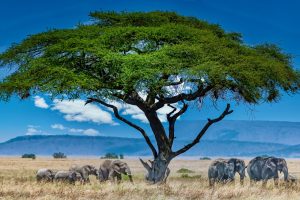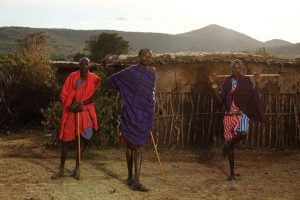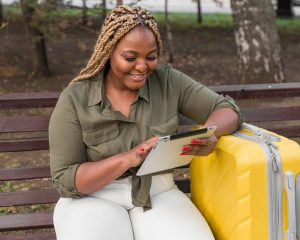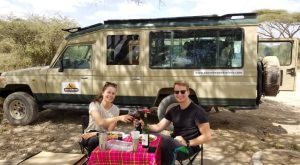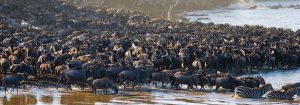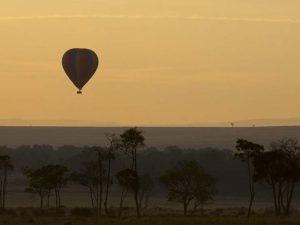Did you know the best time to climb Kilimanjaro will contribute to the success of your adventure?
Mount Kilimanjaro is located near the equator. Thus, this region doesn’t experience extreme winter and summer conditions. Given these situations, the best time to climb Kilimanjaro is the warmest and driest months.
Although you can climb Mount Kilimanjaro anytime, safety is the main issue here. The risks linked with climbing are high when the weather conditions are bad. The effects of bad weather conditions, such as rain, mud, and snow, can overwhelm your body.
As a result, it reduces your chances of succeeding in reaching the summit of Kilimanjaro—likewise, the odds of a successful summit increase significantly during favourable weather.
To learn more about the best time to climb Kilimanjaro, refer to the extensive information below.
The best time to climb Kilimanjaro: All you need to know
Choosing the best time to climb Kilimanjaro is ideal to get the best view of your trek. Trekkers can enjoy the view of Mount Kilimanjaro during its two driest seasons—one from December to early March and the other from late June to the end of October.
These months are the best time to climb Kilimanjaro because you’ll get the best weather and safest conditions in reaching the ‘Roof of Africa.’ Trekking during the rainy season has the likelihood of bringing snow and ice on the higher slopes, leading to muddy mountain conditions.
Thus, the best time to climb Kilimanjaro is during the driest season. To help you see your options, we made a table consisting of the month, season, traffic, and recommendations.
Chart introduction
| Month | Season | Traffic | Weather | Sky | Trails | Recommendation |
|---|---|---|---|---|---|---|
| JANUARY | High | High | Little to no rainfall | Sunny & cloudy | Dry | Recommended |
| FEBRUARY | High | High | No rainfall | Sunny & cloudy | Dry | Recommended |
| MARCH | Low | Low | Short rainfall | Cloudy | Very wet, muddy & snowy | Best to avoid, no traffic |
| APRIL | Low | Low | Long rainfall | Cloudy | Very wet, muddy & snowy | Best to avoid, no traffic |
| MAY | Low | Low | Short rainfall | Cloudy | Very wet, muddy & snowy | Best to avoid, no traffic |
| JUNE | Peak | High | No rainfall | Sunny & cloudy | Dry | Highly recommended |
| JULY | Peak | High | No rainfall | Sunny | Dry | Highly recommended |
| AUGUST | Peak | High | No rainfall | Sunny | Dry | Highly recommended |
| SEPTEMBER | Peak | High | No rainfall | Sunny | Dry | Highly recommended |
| OCTOBER | Peak | High | No rainfall | Sunny | Dry | Highly recommended |
| NOVEMBER | High | Medium | Little to no rainfall | Sunny & cloudy | Wet & muddy | Recommended |
| DECEMBER | High | Medium | Little to no rainfall | Sunny & cloudy | Wet & muddy | Recommended |
Although it’s possible to climb Kilimanjaro all year round, the best time to climb it is during lower precipitation. This way, you’ll have the best view of the mountain, and your success rate is likely to be much higher.
As you can see on the table, the best time to trek Mount Kilimanjaro is from early December to February, but early March will also do. In addition, late June through the end of October is also the best time to climb Kilimanjaro as they’re the driest months and offer the best spectacle of the mountain.
However, it’s also best to note that these months are the busiest (high season). We schedule our group and private climbs correspondingly, ensuring a safe and successful climb to the summit.
The best time to climb Kilimanjaro: the best trekking months
As stated above, you can climb Mount Kilimanjaro year-round. However, choosing the best trekking months for safety and success is best. This way, you have a much higher chance of having a successful summit.
So, we’ve listed the months considered the best time for the Kilimanjaro trek and the unfavourable ones like the rainy seasons.
Kilimanjaro climb In January and February
January and February, the warmest and driest months on Kilimanjaro, unsurprisingly entice numerous trekkers to conquer its heights. Occasionally, some clouds may assemble in the afternoon, but rain is rarely an intrusion. This consistent weather pattern, characterised by little to no rain across different climate zones, further confirms why January and February are popular climbing months on Kilimanjaro.
Kilimanjaro climb in March, April, and May
March, April, and May correspond to the long rainy season in Tanzania, notoriously making this period less desirable for climbers. During this phase, the trails leading to the summit can be excessively wet, muddy, and occasionally even snowy, particularly in the alpine desert zone.
The thick cloud coverage and rainfall during these months can obscure the breathtaking views of the mountain, significantly reducing those splendid photo opportunities you might be looking forward to on your summit attempt.
However, some people like climbing Kilimanjaro when the summit is snow-capped. This can be great for those trekkers who want an additional challenge in their Kilimanjaro climbing adventure.
Kilimanjaro climb In June
June stands as a bridge, marking the shift from the long rainy season to the onset of the dry season. Consequently, this month experiences significantly drier conditions than those seen in March, April, and May.
Despite the generally drier and slightly warmer temperatures during the day, cold weather often descends as night falls due to the high altitude. Hence, it’s crucial to equip yourself accordingly.
Moreover, observing clear skies becomes more common this month, adding to the majestic allure of the journey. However, this shift in weather patterns also ushers in the peak season, with many mountaineers preferring these improved conditions.
As always, remain alert for altitude sickness, a common concern wherever mountain trekking occurs. Clouds will still get cloudy, so you might not have an exceptional view in early June. However, towards the middle to end of June until October, you’ll be greeted by spectacular views of Mount Kilimanjaro.
Kilimanjaro climb In July, August, September, and October
In general, July to October have colder yet drier conditions compared to the past months. Although there might be chances of rain, particularly in the rainforest and moorland parts, the precipitation is low and not frequent.
Remaining dry during the trek will give you the most comfortable and delightful experience overall. In addition, trekking during these months will provide great photo opportunities as the skies are clear and the views are panoramic.
The only disadvantage of these months is that they’re high season. In other words, these months are the busiest.
But you can take this as an opportunity to talk with other groups at the campsites. This way, you can encourage each other to climb the summit of Kilimanjaro successfully.
Kilimanjaro climb In November
November embarks the short rainy season in Tanzania that continues until early December. Expect rainy afternoons but clear morning skies and evenings.
This month isn’t an ideal month to climb, as the trails on Kilimanjaro are typically wet, muddy and very slippery during this time.
Kilimanjaro climb In December
December is still part of the short rainy season. However, many trekkers still enjoy this month, particularly at the end of the month.
The full moon climb on Kilimanjaro

Another popular time to climb Kilimanjaro is during the full moon. Many trekkers are drawn to scale during the full moon due to the stunning view they get during the day and night.
The stunning view of the glaciers lit by the bright moon is undoubtedly a spectacle everyone would love to see. Another benefit of hiking during this time is that the moonlight will enhance your visibility, particularly during the final ascent to Uhuru Peak.
If you want to summit during a full moon, it’s ideal to start your seven-day climb five days before the full moon date and six days before the full moon date for an eight-day climb.
The stunning view of the glaciers lit by the bright moon is undoubtedly a spectacle everyone would love to see. Another benefit of hiking during this time is that the moonlight will enhance your visibility, particularly during the final ascent to Uhuru Peak.
If you want to summit during a full moon, it’s ideal to start your seven-day climb five days before the full moon date and six days before the full moon date for an eight-day climb.
Climb mount Kilimanjaro sooner than later
Climbing Kilimanjaro is a unique experience. The mountain is crowned with ice despite its proximity to the equator.
In addition, the glaciers have existed for over 11,000 years and are more than 300 feet deep, extending 6,500 feet from the mountaintop. However, due to the effect of global warming, the ice has been dissolving at an alarming rate.
In fact, according to scientists, the ice cap of Mount Kilimanjaro is projected to be gone entirely by 2050. So, if you plan to climb Kilimanjaro, it’s best to do it sooner. This way, you’ll have a chance to witness the beautiful and iconic ice cap of the highest free-standing mountain in the world.
Does the weather change on Kilimanjaro
Yes, the weather in Kilimanjaro changes every day. It can vary from hot to cold in one day and experiences significant temperature changes from season to season.
Although the best time to climb Kilimanjaro is during the dry seasons, you may still opt to hike the mountain during the rainy and snowy seasons. However, you must be ready for a much more complicated and dangerous climb.
Conclusion: When we recommend to climb Kilimanjaro
We recommend climbing Kilimanjaro, particularly from January to February. These months are the driest in Kilimanjaro, offering you the best views and many perfect-picture opportunities. Check out our packing list blog, where we dissect what you need to bring to reach the summit.
Furthermore, December to mid-March and mid-June to the end of October are the best times to climb the mountain. Once you’ve decided which month to climb the mighty Mount Kilimanjaro, we recommend contacting our team of professionals.
Our mountaineers have been summiting Kilimanjaro for decades and can help you professionally plan the most exciting summit of your life. We’ll see you on the mountain!
Frequently Asked Questions (FAQs)
When is the optimal time to climb Mount Kilimanjaro?
The ideal periods to climb Mount Kilimanjaro coincide with the dry seasons: January through February and June through October. Trekkers encounter fewer obstructions during these times, thanks to clear skies and little rainfall.
Additionally, these conditions boost safety, enhance visibility, and favour climber enjoyment. Nevertheless, precipitation is only partially unheard of even in these months, so trekkers should always pack waterproof gear.
However, the clear skies during the dry seasons provide spectacular views of the mountain and its surroundings. Remember, regardless of the season, temperatures can drop significantly at high altitudes, so being prepared for cold weather is always necessary.
What is the degree of difficulty for a Mount Kilimanjaro climb?
A climb up Mount Kilimanjaro presents moderate challenges, with the altitude representing the most considerable hurdle. Mount Kilimanjaro doesn’t require technical climbing skills, and the terrain consists mainly of trails with some steep and rugged sections.
However, a good fitness level and appropriate acclimatisation are crucial to enhance your chances of reaching the summit. The trails vary in difficulty across the different routes, with some more challenging than others.
Given this, your health, physical condition, mental preparation, and route choice will factor into the overall difficulty. Always listen to your body and descend if altitude sickness symptoms appear.
What is the summit success rate for Mount Kilimanjaro?
The success rate for reaching the summit of Mount Kilimanjaro fluctuates depending on factors like the climber’s physical fitness and the chosen route. On average, the success rate for main routes hovers between 65% to 85%.
Routes taking longer, allowing proper acclimatisation, have a higher success rate. For instance, the eight-day Lemosho or Northern Circuit routes offer the highest success rates.
Yet, remember that everyone’s body reacts to altitude differently, and reaching the summit should never be prioritised over safety. Even if you don’t reach the summit, climbing Mount Kilimanjaro is worth cherishing.
How much time does climbing Mount Kilimanjaro require?
The length of the climb to Mount Kilimanjaro’s summit primarily depends on the chosen route, with most routes taking between 5 to 10 days for a round trip. The variance in days is necessary for acclimatisation to the escalating altitude.
Generally, the longer the climb duration, the higher the success rate due to more gradual acclimatisation. The recommended minimum duration for any climb is at least six days, although seven or more notably impacts your acclimatisation and overall success rate.
Irrespective of the number of days taken, climbers will be met with various landscapes and climates, making each day unique. The descent is usually faster, typically taking one to two days.
Are any special climbing abilities or technical skills needed to reach Mount Kilimanjaro summit?
Compared to other high-altitude climbs, ascending Mount Kilimanjaro does not require technical climbing skills or specialised mountaineering equipment.
The trail routes mainly consist of hiking trails, though some steep and rugged terrains need climbing over rocks, especially near the summit. What is essential is a reasonable degree of fitness and mental preparedness, as the climb can be physically and emotionally demanding.
It’s also imperative to have high-quality hiking boots and the appropriate trekking gear, especially for cold and wet weather. The altitude is a significant challenge, and understanding how to prevent and manage AMS is vital. Above all, a determined spirit goes a long way in overcoming challenges.
What preparation and training should I undertake before my Mount Kilimanjaro climb?
Physical fitness is paramount when preparing for a Kilimanjaro climb. It is recommended to embark on a training regimen that includes cardiovascular endurance activities, such as distance running, swimming, or cycling, several weeks or months before the climb. In addition, strength training or hiking with a loaded backpack helps build strength and endurance in the leg and core muscles.
Altitude training or spending time at high elevations can also be beneficial. Besides physical preparation, familiarising yourself with the symptoms and management of altitude sickness is vital. Finally, having the right mental attitude and being prepared to face and overcome challenges significantly affects your overall climbing experience and success.
What are altitude sickness symptoms, and how can I mitigate them during my climb?
The altitude sickness symptoms typically include headaches, dizziness, shortness of breath, rapid heart rate, loss of appetite, and difficulty sleeping. The best way to mitigate altitude sickness is through proper acclimatisation, which involves a slow ascent to allow your body time to adjust to the decreased oxygen levels.
Staying well-hydrated, taking regular breaks, maintaining a steady pace, and eating adequately also help offset altitude sickness. Experts suggest using a “climb high, sleep low” strategy for better acclimatisation.
Some climbers opt for prescription medications like Diamox as a preventive measure; however, this should only be done under the guidance of a healthcare professional.
Which route should I select to ascend Mount Kilimanjaro?
There are several potential routes to climb Mount Kilimanjaro, each revealing different difficulty levels, scenic allure, and trip duration. Some well-known routes include the Marangu, Machame, Lemosho, and Rongai routes.
The Machame route is known for its beautiful scenery but has steeper trails, while the Marangu route has a gentler gradient but less scenic variety. The Lemosho route is more extended, provides excellent acclimatisation, and passes through all the climate zones of Kilimanjaro.
Each route offers a unique experience, so your fitness level, interest, and budget should guide your choice. Consulting with a reputable tour operator or guide can help you choose the best route for your abilities and preferences.
What gear and clothing are necessary for the Mount Kilimanjaro climb?
The climbing gear and clothing you need depend on the chosen route and the season. Essential gear includes waterproof and sturdy hiking boots, thermal base layers, an insulated jacket, trekking poles, a rain jacket and pants, gloves, hats, and warm socks.
Layering clothing is recommended as the temperatures can fluctuate dramatically from day to night and between different altitudes. Other supplies include a headlamp, water bottles, a day pack, and high-factor sunscreen.
Remember that the temperatures drop significantly at higher elevations and night, so pack accordingly. Rental options for gear are typically available, but it’s essential to ensure equipment is in good condition.
Is a guide needed to climb Mount Kilimanjaro?
Yes, as per Tanzanian law, it is mandatory to have a licensed guide for climbing Kilimanjaro, and numerous climbers opt for additional support personnel, including porters and cooks, to assist with the journey.
The guide enhances your safety, helps with navigation, provides critical information about the mountain, and aids in spotting wildlife. Furthermore, they can gauge whether climbers suffer from altitude sickness, a common difficulty on the hill, and decide if and when a climber should turn back.
The support staff also enhance the climbing experience by freeing you from carrying heavy loads, preparing meals, and setting up and breaking down camp daily.
What is the total cost of climbing Mount Kilimanjaro?
The total cost to climb Kilimanjaro ranges significantly based on the selected route, the length of the climb added services, and extras like gear rentals, additional support staff, or VIP services. The average cost is $2,000 to $4,000 per person, excluding tipping the guide and crew, personal gear, and flights.
The cost includes park, camping or hut fees, rescue fees, VAT, and services such as meals, guidance, and porters. Be cautious of operators offering significantly low prices, as they may be cutting corners with safety, equipment quality, or wages for their staff.
Do I need a visa or any permits to climb Mount Kilimanjaro?
A Tanzanian visa is typically required to climb Kilimanjaro, which can be acquired from a Tanzanian embassy in your home country or upon arrival at the airport. Permit fees for the Kilimanjaro National Park are usually included in the package provided by tour operators.
However, such climbing permits are only issued to licensed guides and tour operators rather than individual climbers. All climbers are required to register and complete a medical check before beginning their climb. Hence, going through a reputable tour operator can help streamline the process.
How do I select a reputable tour operator or guide for my Mount Kilimanjaro climb?
Choosing a reputable tour operator affects your experience and safety during the climb and ensures responsible tourism practices like fair porter wages. Look for operators with good online reviews, positive recommendations from past climbers, and membership in recognised mountaineering and travel associations.
Select operators that uphold ethical and responsible standards, including treating their porters and the environment responsibly. Be wary of deals that seem too good to be true, as some operators severely underpay their staff or skimp on essential services.
Are vaccination and health requirements necessary to climb Mount Kilimanjaro?
Before your trip, see your healthcare provider about the recommended vaccinations for Tanzania. These may include routine and travel vaccines like yellow fever, typhoid, and hepatitis A.
Though Kilimanjaro is not in a malaria-risk zone, you may spend time in other parts of Tanzania that are, so discuss this with your healthcare provider—carrying a personal first aid kit with medications for common ailments like diarrhoea, altitude sickness, and cold. All climbers should consider undergoing a medical check to ensure they are fit and healthy ahead of their climb.
Is travel insurance mandatory for climbing Mount Kilimanjaro?
While not mandatory, it is highly advisable to have travel insurance that covers explicitly high-altitude trekking up to 6,000 meters. Ensure your policy covers emergency rescue, evacuation, medical treatment, and trip cancellation or interruption.
Remember, the cost of an emergency evacuation from the mountain can be high, and hospitals in Tanzania require upfront payment. Hence, insurance is a safety net that every climber should have. Certain tour operators mandate proof of adequate travel insurance before allowing you to embark on your climb.

